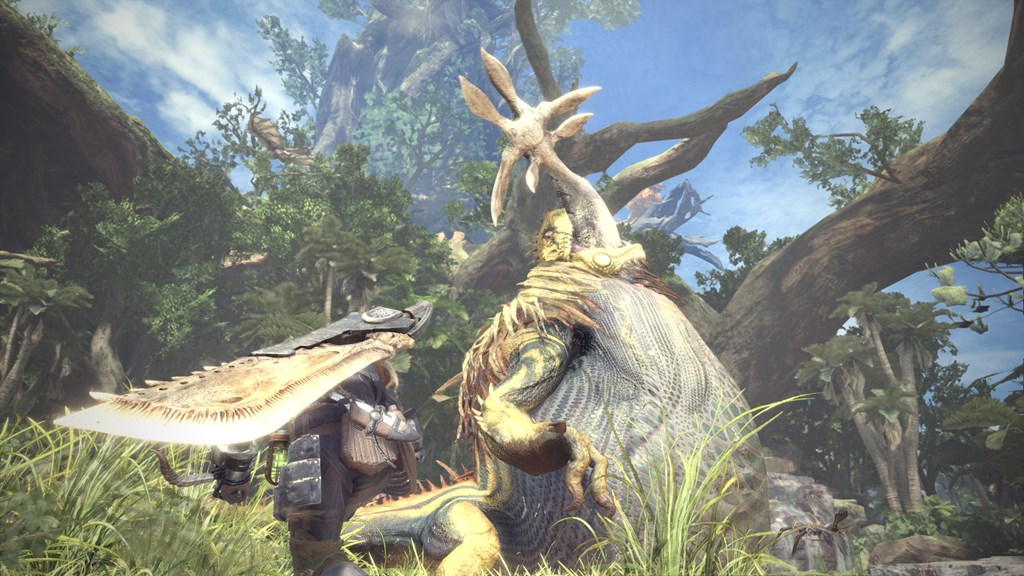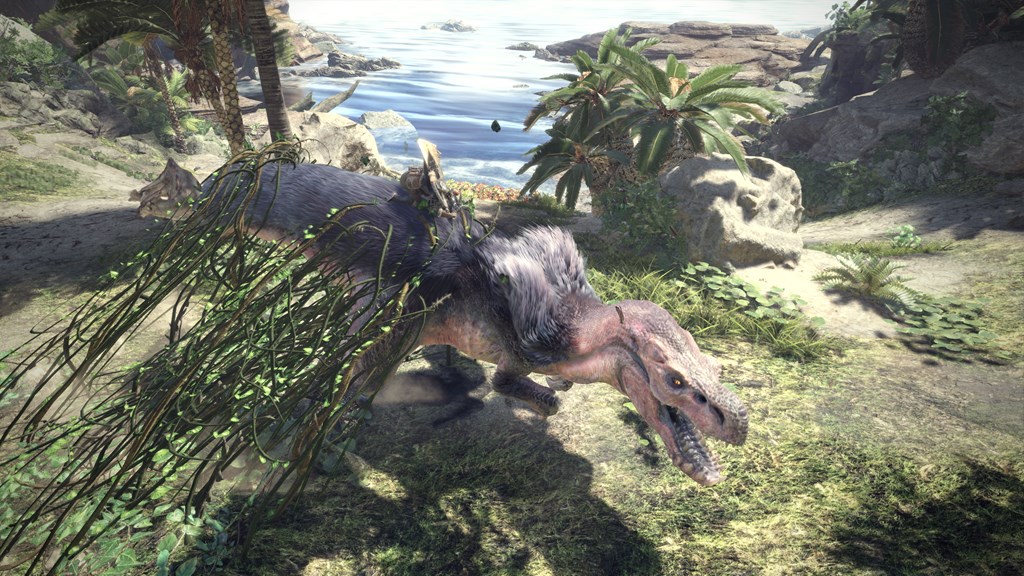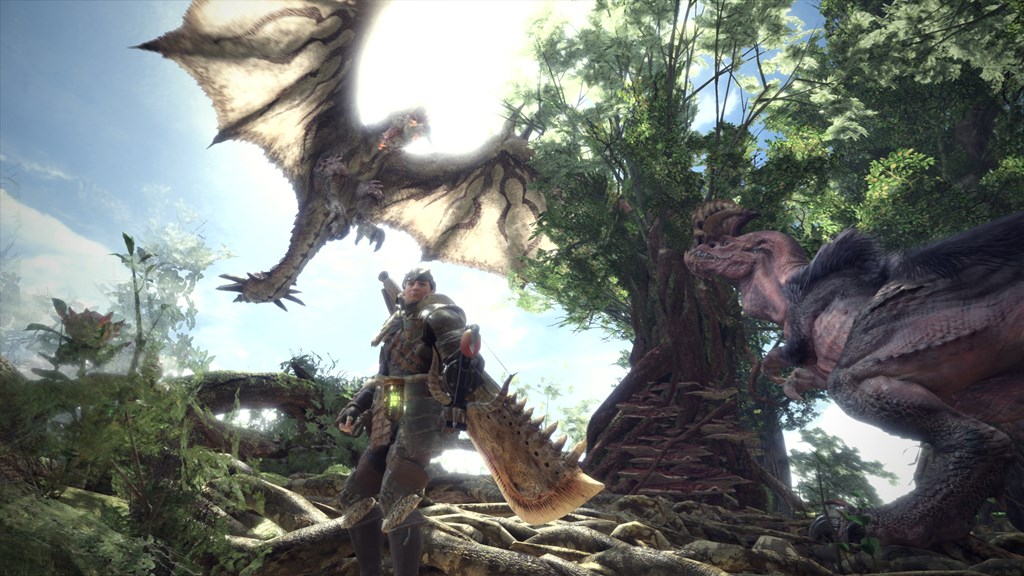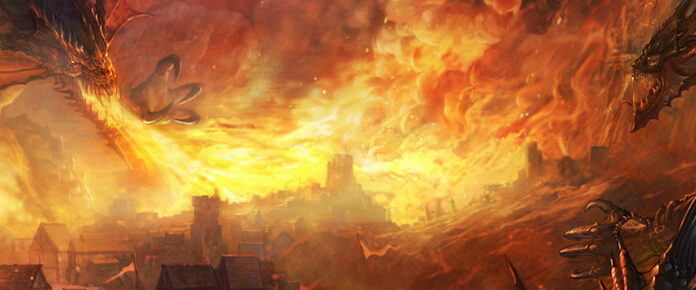
Monster Hunter World‘s reveal caught me completely off guard during its E3 2017 reveal. We’d already had a title announced for the Nintendo Switch, and I’d figured that was our usual non-spinoff MH entry for the year. I’ve admittedly not finished or heavily invested in the series since leaving Japan, but part of that is because the American mobile gaming culture doesn’t really have the fanbase Japan does. In fact, I got into Monster Hunter Tri in a bad way because it was a console title. While the portability of the series really helped me to explore Japan’s gaming scene and meet fellow gamers face-to-face, my gut feeling upon seeing MHW’s console and PC plans was that Capcom might really be able to catch the western audience this time. And that was before seeing Monster Hunter lead designer Yuya Tokuda play the game in real time.
Why Monster Hunter
Massively OP’s actually covered some news for Monster Hunter but never actually really had any in-depth articles on the game since it’s not exactly in our wheelhouse, being a non-massive title. For those who’ve never played the series, just know that Monster Hunter is a game series about going out, killing bosses, and turning their body parts into armor. It’s essentially all raids, all the time. In fact, I’ve read that the game was originally made based on MMOs, and it shows: The series requires players to learn a kind of action combat dance, farm for consumables to help assist with that, and constantly grind bosses to increase in rank while gaining cool new armor. The games tend to be for 4 players max, hardly massive by themselves, but akin to Pokemon Go, the local multiplayer scene (in Japan) is so large that you can often find someone to play with if you’re looking, though a pick-up “raid” on the train might be risky (got one done on a bus once, though!).
I haven’t thoroughly enjoyed MMO raiding in a long time, but when I have an urge to grind gear tiers, Monster Hunter is my go-to game. The MMO feel on a smaller scale that gets me on the grind wheel from day one feels honest compared to many open feeling MMOs that “end” with my being funneled into raiding to get the best gear available. That’s why there’s been a western demand for an actual MH MMO, especially because Japan and other Asian countries have gotten two already. However, as Asia has the very strong mobile scene the series traditionally caters to, the games and their local multiplayer culture struggle to translate in feeling when going abroad. This is why a console port, and one that also taps into the western PC culture Japan lacks, is so surprising.
Maestro of monsters
Although what I saw was a hands-off theater demo, seeing someone play Monster Hunter live gives a better impression of the game when compared to most demos due to the series’ technical nature. Think Dark Souls, but perhaps slightly less punishing. The combat dance is real, and a single hit can sometimes take you down to half health or less. There may be no friendly damage, but friendly fire is on, so if you stand too close to a friend swinging a hammer or a pugger starts shooting her bow while you’re standing in front of her, you’re gonna get knocked around, possibly into the direct path of a literal sand whale. I spoke to a few other people who saw the demo, and they confirmed my suspicion that even Tokuda himself made mistakes during the demo as he played it. That should give you an idea of how much of a learning curve is involved in the game.
But the demo showed more than just skills. Usually the series’ voice acting is limited to manly grunts and girlish giggles, not actual sentences, and MHW is changing that. It makes the game more cinematic and easier to watch — but also more difficult to localize, meaning Capcom is really trying to appeal to international markets rather than just a simple idea of a singular, homogeneous global market.
The game also looks more accessible in some ways. There’s still a timer keeping pressure on the player, and players still have to “carve” monsters/monster parts to collect items before they disappear (tails and other body parts can be cut off or even broken, preventing monsters from using certain attacks).
That being said, there’s some streamlining. Gone is cycling through items, replaced with a radial dial that lets you pick whatever you need. Sliding down hills helps players gain speed as they traverse the environment. The “Palico” (Pal+Calico) assistants return to help hunters with their quests, but players can also go to a base camp to change their gear, both weapons and armor, something generally unheard of in the series. Think of it like being able to use your bank in the middle of a raid, which is exactly something Tokuda did during the demo, switching not only his armor setup but his melee weapon for a ranged one.
Consumables on display in the theater demo were all used while on the move. Old school MMOs players probably played at least one title that required your character to stop moving in order to activate such items, but it’s probably a dated requirement for modern gamers, so Capcom’s allowing not only food but resource gathering without forcing players to stand still streamlines the action. As Tokuda stalked his prey throughout the demo, I saw him grabbing minerals, herbs, and other items he’d eventually use, like crafting some camouflage to hide from the monster.
Visual tracking is also amped up. Gone are the days of wandering from zone to zone to find your target, as the map is one large open area with clues about where your target is. Not only do players get “scout flies” that create a glow effect pointing towards the monster, but we see things like broken trees, footprints, and in this monster’s case, mucus, all of which lead us to our prey, the new Anjanath. The visuals don’t just help to simplify gameplay but solidify immersion.
Law of the Land
Indeed, immersion is a big factor that started to affect the demo once the monster came into play. Monster Hunter games tend to have good environmental interaction, having everything from destructible landscapes to climbing and even the ability to use the terrain to leap onto monster’s back to rodeo it. However, MHW ups the ante. While the terrain is often destructible in other MH games, it’s often passive at best, being destroyed to change the battlefield or maybe usable for trapping a horned monster by tricking it into charging and trapping itself. In the theater demo, Tokuda did so much more.
For example, he used a “slinger” to throw rocks and other items around. This allows for things like tricking a monster into thinking something is across from you and luring it in a new direction. That may not sound like much, but even more so than in previous games, monsters interact with their environments. Monsters may still eat other monsters for health, call for help, or run toward certain areas to rest, but they’ll also try to use terrain to smash a player riding them or vomit up their food to attract friends.
You can even use this to your advantage. As at one point, Tokuda was dealing with three monsters all trying to eat each other. One monster, dragon-like MH series mascot Rathalos, was lifting another up Anjanath to fly away with it after it entered its nest. Another monster, newcomer Great Jagras, approached, perhaps originally seeking Rathalos eggs and calling for its friends. They slowly tried to eat the larger Anjanath while it was still alive. Caught in the middle, Anjanath was trying to fight off both the Rathalos and the Jagras family, while the Rathalos and Jagras noticed the other was also after its predator-turned-prey and attacked each other. It was gruesome, like something out of nightmarish National Geographic documentary, but also smart game design we’re constantly being told MMO developers want but nearly never pull off.
During the fights, Tokuda threw rocks to make terrain crash down on his prey. He angered flies capable of temporarily blinding the Anjanath or lured it to nearby vines to tangle it up, making it unable to move and thus much easier to land prolonged attacks. In general, the new environmental interaction gives players more ways to open the monsters to repeated attacks, something they nearly never do without players using consumable traps, engaging electric stunning weapons, or repeatedly bashing beating it in the head to daze it. In MH, the monsters and characters are nearly always moving, and players are stealing chances to attack as they essentially are forced to take turns “tanking” as the monster constantly shifts its focus among different party members.
As the hunt goes on, day shifts to night. The activities of the monsters adapt. Tokuda switched weapons, but he was making some mistakes. I realized he was in gear that was probably over-tuned for the hunt. He was getting hit but it wasn’t too bad. I know this because big monsters usually cause big damage, and Anjanath is fairly large and breathes fire to boot.
Tokuda them used the environment itself like a weapon. He hidin bushes and leaped out of trees. The monster was smashing rock formations, trying to crush Tokuda. I stopped looking for flashing lights on trees expecting something to highlight what can and can’t be interacted with because, by this point, it felt like an organic world that’s completely interactive. I was almost surprised that the player can’t just pick up dirt and throw it in the monster’s eye.
The demo ended almost like a reverse Jurassic Park. Small, hungry dinos found the Anjanath mid-combat with Tokuda, its leader noticeably absent. Perhaps it died of its wounds, but those little guys were hungry, and they could see that the Anjanath was weakened. It tried to fight them off, but the combination of Tokuda and the smaller dinos was too much: It died, completing Tokuda’s quest.
In the final moments of the demo, I realized the nature of the game has changed a bit. This isn’t our usual raid-like past entries. The combat dance is still there, still relevant, but we have more tools available to use, more options for when and how to engage. I’m trying to figure out how multiple hunters fit into this world if everyone is felling trees that don’t simply respawn.
A second look
Since the E3 demo, players have leaked a different version of the demo, and this one included multiplayer in ways the Japanese preview didn’t. The players in that video treated the hunt completely differently. There’s a dam that breaks during the battle, something I wasn’t aware of even existing in Tokuda’s playthrough. The water sweeps up the player and boss monsters alike, sending them over a cliff. As if in some action movie, the player grapples a branch on the way down using the slinger (something we didn’t see in the solo demos), enabling him to stay oriented as the injured monsters flail around injured on the ground. The player hops down and shoots a flare to call friends. The other players enter the game, not too far from the action.
Now we see some use for multiplayer. One of the bosses, the dragon-like Rathalos, is trying to fly away, but one of the players mounts it in mid-air, repeatedly stabbing it and knocking it out of the sky. The gameplay is so organic now I admittedly fan-freaking in real life. This is combat immersion even VR can’t replicate yet.
Rather than stealthily moving through bushes, they swing on vines like Tarzan. Despite there being several of them, they’re unable to cut off Anjanath, forcing them to be extra cautious of his tail attacks. It’s completely different from my single player demo and reminds me just why this is my go-to raiding series. It may not have a massive number of players or deep social systems, especially by divorcing itself from local multiplayer, but Monster Hunter World’s action is tighter and grander than what I’d expect most MMOs being able of pulling off.


















